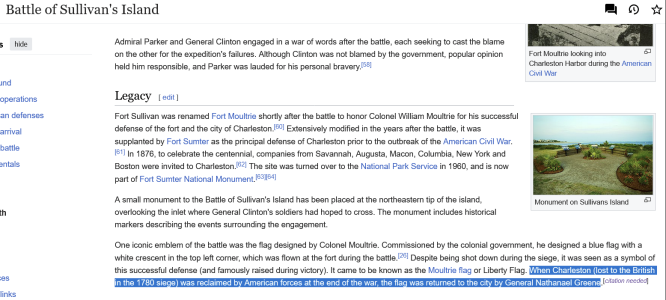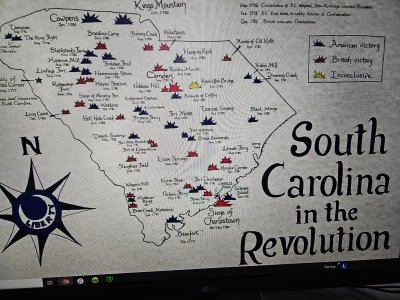The Battle of Sullivan's Island was fought near Charleston, SC. Also known as the First Siege of Charleston, the battle was a victory for South Carolina and resulted in over 200 casualties for the British occupiers.
In early June 1776 General Henry Clinton and Admiral Sir Peter Parker led a British expeditionary force and decided to land at Long Island (modern day Isle of Palms) which was separated from Sullivan's Island by Breach Inlet. Colonel William Moultrie of the South Carolina Militia had commanded the hasty construction of "Fort Sullivan" (later renamed Fort Moultrie in honor of Moultrie's bravery) in preparation of a British naval bombardment and land assault.
Ahead of the assault the British were confident of their ability to quickly take the fort and control the entrance to Charleston harbor. The fort was not even completed and the British had nine warships totaling nearly 300 cannons within range and over 2000 infantryman on Long Island.
On June 7, Clinton issued a proclamation calling on the rebel colonists to lay down their arms, however the SC militia manning the cannons at Fort Sullivan fired on the vessel (which was carrying a truce flag) sent to deliver it. The British found Breach Inlet too deep to wade and attempted to ferry troops across by boat but were met with cannon and rifle fire from the Militia and the land assault was abandoned.
On the morning of June 28th, the British launched the naval bombardment of the fort. Cannon fire rained down on the fort but had little impact as the walls had been constructed with palmetto logs and the cannonballs just stuck in the soft wood instead of splintering. The SC Militia returned fire and sank or damaged five of the British ships.
At one point during the battle, the flag that Moultrie had designed for the fort had fallen.

Sgt. William Jasper braved enemy fire to raise the flag again over Fort Sullivan.

This "Moultrie Flag" would later become the basis for the South Carolina flag as an image of the palmetto trees that were used to construct the walls of the fort was added to the flag.
In the end, the British were defeated and wouldn't return to try and take Charleston until 1780. But that wouldn't be the last Revolutionary War battle fought in South Carolina, as the there were more than 200 battles fought in the Palmetto State, more than any other colony.
In early June 1776 General Henry Clinton and Admiral Sir Peter Parker led a British expeditionary force and decided to land at Long Island (modern day Isle of Palms) which was separated from Sullivan's Island by Breach Inlet. Colonel William Moultrie of the South Carolina Militia had commanded the hasty construction of "Fort Sullivan" (later renamed Fort Moultrie in honor of Moultrie's bravery) in preparation of a British naval bombardment and land assault.
Ahead of the assault the British were confident of their ability to quickly take the fort and control the entrance to Charleston harbor. The fort was not even completed and the British had nine warships totaling nearly 300 cannons within range and over 2000 infantryman on Long Island.
On June 7, Clinton issued a proclamation calling on the rebel colonists to lay down their arms, however the SC militia manning the cannons at Fort Sullivan fired on the vessel (which was carrying a truce flag) sent to deliver it. The British found Breach Inlet too deep to wade and attempted to ferry troops across by boat but were met with cannon and rifle fire from the Militia and the land assault was abandoned.
On the morning of June 28th, the British launched the naval bombardment of the fort. Cannon fire rained down on the fort but had little impact as the walls had been constructed with palmetto logs and the cannonballs just stuck in the soft wood instead of splintering. The SC Militia returned fire and sank or damaged five of the British ships.
At one point during the battle, the flag that Moultrie had designed for the fort had fallen.

Sgt. William Jasper braved enemy fire to raise the flag again over Fort Sullivan.

This "Moultrie Flag" would later become the basis for the South Carolina flag as an image of the palmetto trees that were used to construct the walls of the fort was added to the flag.
In the end, the British were defeated and wouldn't return to try and take Charleston until 1780. But that wouldn't be the last Revolutionary War battle fought in South Carolina, as the there were more than 200 battles fought in the Palmetto State, more than any other colony.



